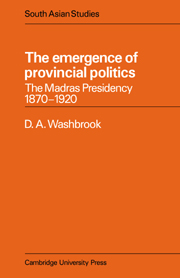Book contents
- Frontmatter
- Contents
- Preface
- Abbreviations, notes on references and spelling
- Introduction
- 1 The Madras Presidency
- 2 The governance of Madras
- 3 The political economy of Madras
- 4 Local structures of political power
- 5 The emergence of provincial politics
- 6 The vocabulary of communal politics
- 7 The Home Rule League, Justice Party and Congress
- Conclusion
- Glossary
- Bibliography
- Index
1 - The Madras Presidency
Published online by Cambridge University Press: 21 September 2009
- Frontmatter
- Contents
- Preface
- Abbreviations, notes on references and spelling
- Introduction
- 1 The Madras Presidency
- 2 The governance of Madras
- 3 The political economy of Madras
- 4 Local structures of political power
- 5 The emergence of provincial politics
- 6 The vocabulary of communal politics
- 7 The Home Rule League, Justice Party and Congress
- Conclusion
- Glossary
- Bibliography
- Index
Summary
By 1800, the British had acquired most of what was to become their presidency of Madras. They found themselves in possession of a collection of territories which covered about 140,000 square miles and which, between 1870 and 1920, came to contain a population of some 30 to 40 millions. The province was certainly the most artificial of all those held by the British in India. Its administrative and formal political unity masked enormous economic, linguistic and cultural diversities. The presidency was composed of seven clearly distinct geophysical regions, each with its own economy. Around the Cauveri and the Kistna–Godavari deltas, there were two areas of intensive rice cultivation. From the Kistna and Godavari hills, south and west through the Ceded Districts (Anantapur, Bellary, Kurnool and Cuddapah) and hinterland Tamilnad (North and South Arcot, Salem, Coimbatore, Madura, Trichinopoly and Tinnevelly districts) stretched a region which, though giving way to cattle–breeding on higher ground and to rice cultivation along the banks of occasional rivers and tanks, was mainly under systems of ‘dry’ cultivation. The basic produce were grains of the combu, cholum and ragi varieties, and cotton and groundnut cash crops – all grown without sophisticated irrigation works. In the south–west and north–east of the presidency, ranges of hills broke up the plains and plateaux: in the former area, the Nilgiri and Palnad hills attracted European tea and coffee planters who came to dominate the local economies; in the latter, the ‘Agency tracts’ of Ganjam, Vizagapatam and Godavari districts continued to be populated by tribal groups with only the most primitive forms of settled agriculture.
- Type
- Chapter
- Information
- The Emergence of Provincial PoliticsThe Madras Presidency 1870–1920, pp. 11 - 22Publisher: Cambridge University PressPrint publication year: 1976

